Scientists need it. Cyclists and joggers love it. And an Ottawa hospital wants it. But the fight for the right to the Central Experimental Farm in Canada's capital could soon be coming to a resolution.
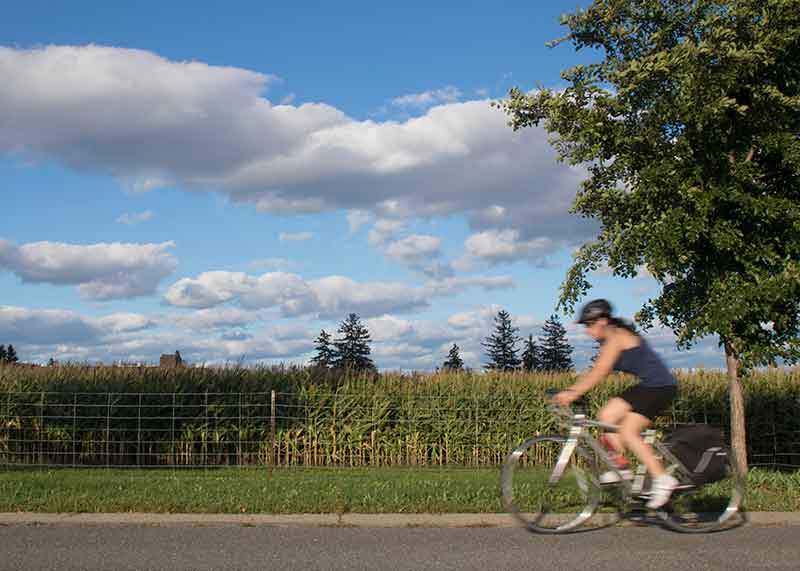
“There is a bit of a war of attrition going on. There are other groups who have eyes on this farm,” says Maitland. “Look around. This is prime real estate.”
That real estate belongs to the Central Experimental Farm: a sprawling federal research site that also happens to be one of the most heavily-used public spaces in Canada’s capital. It’s a rarity in North America, where few cities can boast of having a working farm in the middle of their urban core – never mind one that’s also a regular hangout for cyclists, dog walkers, and rollerbladers.
But thanks to a promise made two years ago to a local hospital, just who ends up with a significant chunk of the farm’s northern grounds is an open question. And if advocates like Maitland – a board member with Heritage Ottawa and a prominent voice in a coalition to save the farm – had their way, the question never would’ve been asked at all.
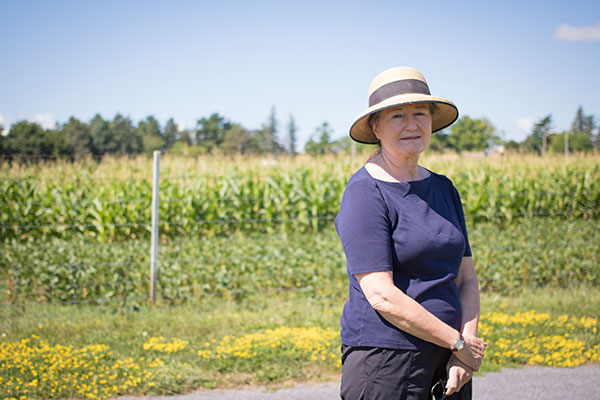
Leslie Maitland of Heritage Ottawa stands in front of a cornfield that’s part of a 60-acre Central Experimental Farm site that, in 2014, was promised to the Ottawa Hospital for an expansion project.
Since its establishment in 1886, the Central Experimental Farm’s priority has been agricultural research. A federal act passed that year spelled out some of its priorities: answering questions about the dairy industry, studying plant diseases and treatments, and measuring the merits of everything from stock breeds and fertilizers to fruits and vegetables.
The farm was in the countryside then, but by the 1930s Ottawa had grown large enough to start encroaching upon it. For scientists, that meant they no longer had to reside on the farm; it also meant more non-scientists could visit. In the early 1980s, the Canada Agriculture and Food Museum opened on the grounds, drawing both residents and tourists; fifteen years later, the farm was designated a National Historic Site, Canada’s premier heritage designation.
Then came 2007. Facing issues with cramped, aging infrastructure, The Ottawa Hospital decided to would begin looking for land on which it could expand its nearly century-old Civic Campus. A steering committee looked at 12 potential sites, and in 2014 Canada’s Conservative government announced that 60 acres of the farm’s northern lands – lands that happened to be right across a major arterial road from the Civic – would be severed and donated to the hospital.
Local politician John Baird, whose portfolio at the time included the National Capital Commission (NCC), a federal oversight body responsible for the capital, proclaimed with pride that the land grant would bring a “world-class medical facility” to Ottawa.
“The announcement was a shock,” recalls Steve Gleddie, who spent spent more than three decades working out of a research building on the farm before retiring a few years ago. “All the scientists were shocked to hear it. The science that’s actually happening in the fields, the raison d’etre for the farm, is often overlooked.”
Most days, if you take a jaunt through the farm, you’ll see that research in action, from tractors churning through fields to pick-up trucks ferrying scientists and their equipment along the dusty trails. Although the farm’s total land covers just north of 1,000 acres, the 60-acre block represents “close to 20 percent of [its] total useable crop research area,” explained the National Trust for Canada in 2015 when it deemed it one of the most endangered historical sites in the country.
Early-season soybeans, which account for about a million acres in Ontario alone, were developed there, says Gleddie. The site’s also home to a long-term study on soil tillage that’s been going on for more than two decades, making it one of the longest of its kind in the world. (A few years ago, in an attempt to convey the significance of the farm’s research, farm supporters installed a large billboard by the study site, explaining it in great detail.)
“Yes, [the tillage experiment] could be moved, but you’re starting the clock again. You’re losing 25 years of data,” says Gleddie. “I think that’s the most compelling reason that I could give you. There are others in there, but that’s pretty compelling.”
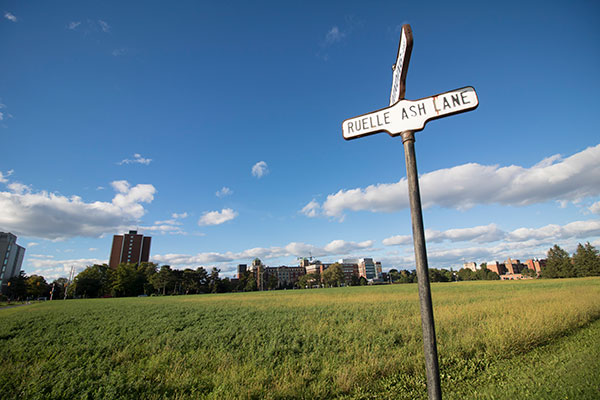
Many of the Central Experimental Farm’s pathways have pastoral-sounding names – like Ash Lane, which runs parallel to The Ottawa Hospital’s Civic campus and through a 60-acre site that was promised in 2014 to the hospital for an expansion project.
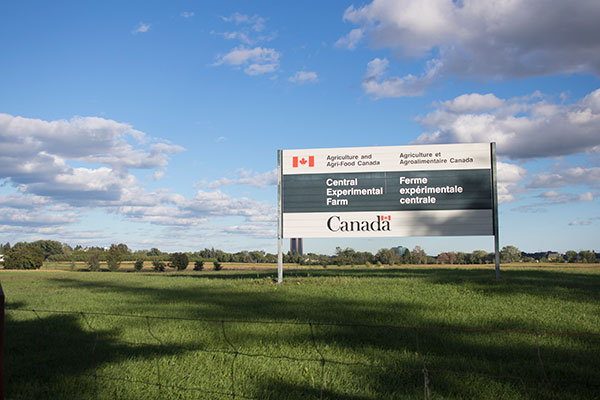
Founded in the late 19th century, the Central Experimental Farm in Ottawa now encompasses more than 1,000 acres and is home to some of Canada’s most significant agricultural research.
But the reasons to offer the 60 acres to the hospital are compelling, too. While no one from The Ottawa Hospital was available for an interview, officials have spoken to local media at length about the new facility’s needs: proximity to the city’s core, access to the major provincial highway that cuts through Ottawa, a space that doesn’t require buildings to be demolished or contaminated soil to be remediated. Based solely on those requirements, giving the Central Experimental Farm land to the hospital makes a reasonable amount of sense.
In a speech to the city’s chamber of commerce earlier this year, reprinted by the Ottawa Citizen, hospital CEO Jack Kitts put the challenges facing both patients and medical staff at the Civic Campus in stark terms. “We have to move critically ill patients from the Emergency Department on the first floor, to the MRI unit on the second floor, and then to operating rooms on the third floor. At one of Canada’s busiest trauma and acute care centers, we waste precious minutes moving patients,” said Kitts. “Imagine how frustrating it is, for our professionals to know that with a modern facility, they could save more lives and limit more suffering.”
“We can find a good place for the hospital. And we don’t have to lose this scientifically important acreage.”
Few would argue that there’s a need to modernize the Civic campus. A 2013 investigation by the Canadian Broadcasting Corporation into the state of Canada’s hospitals gave the Civic a “C” grade, citing, among other things, a lack of single-bed rooms. Even the farm coalition’s advocates would likely support the idea of a new, improved hospital, had it not been slated to be built where it was.
And, as it turns out it, might not be. The Conservatives, who promised the land to the hospital, were kicked out of office during the 2015 federal election, and the new Liberal government has – at least publicly – shown they’re willing to reconsider the severance of the farmlands.
A few months after October’s election, and facing a wave of public backlash, the hospital announced that it would take a second look at four of the original 12 potential project sites, three of which were still on the farm. Then, after being urged on by the country’s new heritage minister, Mélanie Joly, the NCC’s board voted to essentially restart the site selection process from scratch – and earlier this month, the final list of 12 possible sites were revealed.
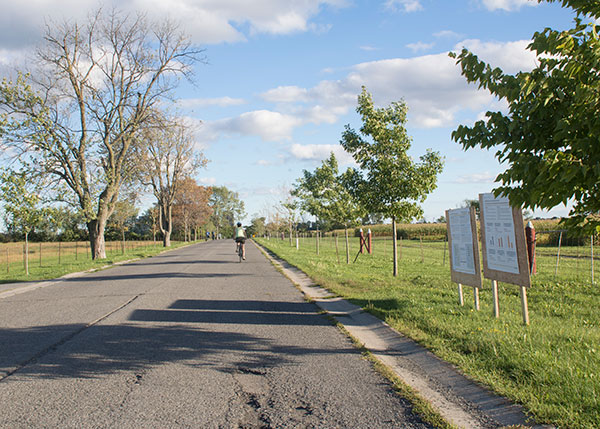
A cyclist makes their way down one of the Central Experimental Farm pathways in Ottawa, past billboards that explain a long-running soil tillage experiment that’s under threat from a local hospital’s expansion project.
The new list includes sites in the city’s southwest suburbs, far from both the farm and the current Civic hospital, as well as property on Tunney’s Pasture – which, despite its bucolic name, is actually a complex of federal government buildings just a couple of miles to the north. It also includes the sites on the farm, including the original, contentious 60 acres. That prompted the lone Conservative MP in Ottawa to survive the 2015 election, Pierre Poilievre, to issue a statement suggesting the whole process was “spinning in circles.” Nevertheless, public consultations began today, September 22, with a final decision expected in November.
“We would not have had an opportunity to revisit this if the Conservatives had been re-elected,” says Maitland, who grew up strolling the farm’s pathways and is tentatively optimistic both sides will get what they want. “There’s a growing awareness of the significance of the farm, and a sense that we can have both. We can have a win-win.”
She continues: “We can find a good place for the hospital. And we don’t have to lose this scientifically important acreage.”